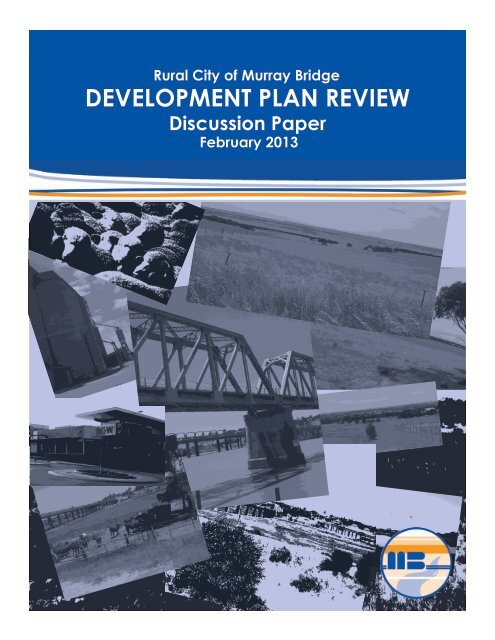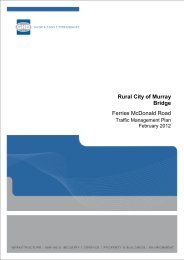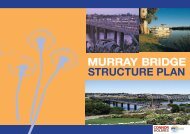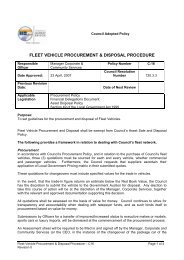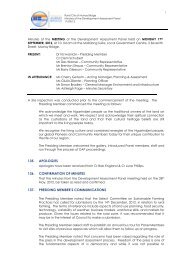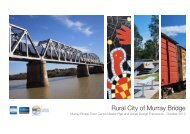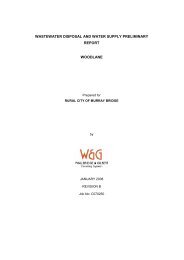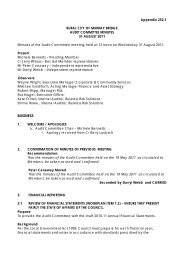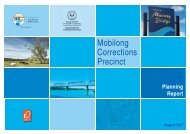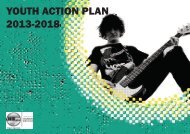development plan review - Rural City of Murray Bridge - SA.Gov.au
development plan review - Rural City of Murray Bridge - SA.Gov.au
development plan review - Rural City of Murray Bridge - SA.Gov.au
- No tags were found...
Create successful ePaper yourself
Turn your PDF publications into a flip-book with our unique Google optimized e-Paper software.
To address this issue, Council is currently undertakinga ‘<strong>review</strong>’ <strong>of</strong> its Development Plan in order to:• address the strategic <strong>plan</strong>ning issues relating tothe <strong>Rural</strong> <strong>City</strong> <strong>of</strong> <strong>Murray</strong> <strong>Bridge</strong> and its community,• set priorities to achieve orderly and efficient<strong>development</strong>, and,• Implement the key recommendations <strong>of</strong> Council’sstrategic <strong>plan</strong>ning documents and relevanttargets and policies outlined within ‘The PlanningStrategy for South Australia’.The area affected by the Development Plan Reviewis spatially shown in Figure 1, and covers all <strong>of</strong>the <strong>Rural</strong> <strong>City</strong> <strong>of</strong> <strong>Murray</strong> <strong>Bridge</strong>.This discussion paper seeks to explain:• How you can contribute to the process,• What is a Development Plan,• What is a Development Plan Amendment,• The Development Plan Review process,• The South Australian Planning Strategy and howit affects the <strong>Rural</strong> <strong>City</strong> <strong>of</strong> <strong>Murray</strong> <strong>Bridge</strong>,• the State and Council’s Strategic Goals for landuse <strong>plan</strong>ning,• Recent land use <strong>plan</strong>ning studies and relevantcurrent projects, and,• The proposed Development Plan program forthe next 5 years.Figure 1: Study Area Covered by the Development Plan Review4 RURAL CITY OF MURRAY BRIDGE
How to Make a SubmissionThis Discussion Paper for the ‘Development PlanReview’ aims to provide appropriate informationto allow you to comment further on what changesyou believe should be made to the <strong>Murray</strong> <strong>Bridge</strong>Council Development Plan to ensure that the community’svision can be translated into policies forthe Development Plan.The proposed Development Plan Amendment programfor the next five years is detailed in Section 7for your comment.Written submissions on the Development Plan Reviewdiscussion paper can be provided by letter,fax or email addressed to Council by 5pm Monday,8 April 2013.Any person who makes a written submission has theopportunity to support their proposals at a publichearing to be held at the Mobilong CommitteeMeeting Room in the Local <strong>Gov</strong>ernment Centre,Seventh Street, <strong>Murray</strong> <strong>Bridge</strong> on Wednesday, 17thApril 2013 at 5pm.Written submission should clearly indicate whetheryou wish to be heard in support <strong>of</strong> your submissionat the public hearing. If no submissions request tobe heard at the public meeting, a meeting will notbe held on that night.Written submission should be addressed to:Development Plan Review 2013<strong>Rural</strong> <strong>City</strong> <strong>of</strong> <strong>Murray</strong> <strong>Bridge</strong>PO Box 421, <strong>Murray</strong> <strong>Bridge</strong> <strong>SA</strong> 5253Email:<strong>development</strong><strong>plan</strong><strong>review</strong>@murraybridge.sa.gov.<strong>au</strong>Fax: 08 8532 2766If you have any queries about the DevelopmentPlan Review process or the recommendations containedwithin this discussion paper, please contacteither <strong>of</strong> Council’s Senior Policy Planners Daniel Herrmannon 8539 1121 or Mabel John on 8539 1151.DEVELOPMENT PLAN REVIEW 20135
6 RURAL CITY OF MURRAY BRIDGE
ContentsContext 3How to Make a Submission 51. Introduction 81.1 What is a Development Plan? 91.2 What is a Development Plan Amendment? 91.3 The Purpose <strong>of</strong> a Development Plan Review 102. Previous Development Plan Review 113. The Planning Strategy for South Australia 143.1 30 Year Plan for Greater Adelaide 153.2 <strong>Murray</strong> Mallee Region Plan 164. The Vision for the <strong>Rural</strong> <strong>City</strong> <strong>of</strong> <strong>Murray</strong> <strong>Bridge</strong> 174.1 Imagine Your <strong>Rural</strong> <strong>City</strong> 2020 184.2 Community Plan 2012-2020 184.3 Strategic Plan 2011-2015 195. Council’s Strategic Growth Studies 205.1 <strong>Murray</strong> <strong>Bridge</strong> Structure Plan 225.2 <strong>Murray</strong> <strong>Bridge</strong> Town Centre Master Plan & Urban Design Framework 245.3 <strong>Rural</strong> Communities Study 266. Primary Production and Environmental Sustainability 296.1 Primary Production 306.2 The Interface Between Primary Production and Township Areas 306.3 River <strong>Murray</strong> Flood Plain 316.4 Environmental Sustainability 327. Proposed Development Plan Amendment Program 33DEVELOPMENT PLAN REVIEW 20137
The <strong>Rural</strong> <strong>City</strong> <strong>of</strong> <strong>Murray</strong> <strong>Bridge</strong> last comprehensively<strong>review</strong>ed its Development Plan in 1998.The 1998 Review identified a number <strong>of</strong> issues thatneeded to be examined as they related to thewhole <strong>of</strong> the Council area including:• riverfront areas at <strong>Murray</strong> <strong>Bridge</strong>,• rural land division policies,• urban land division/ infill <strong>development</strong> standards,including medium density guidelines,• town centre <strong>development</strong>,• rural living and country living,• intensive animal keeping and buffer standards,• tourism,• environmental issues,• industrial <strong>development</strong>,• riverine environment,• waste management, and,• local heritage.The <strong>review</strong> also identified the need to address various‘general’ policy issues that related to the entireCouncil, such as the need to adopt a more userfriendly Development Plan, buffers in rural areas,renewal <strong>of</strong> shack leases, car parking standards incentres, and land division standards.A summary <strong>of</strong> the Development Amendments(formerly ‘Plan Amendment Reports’) proposedthrough the 1998 <strong>review</strong> is provided in Table 1.As identified in Table 1, aspects <strong>of</strong> each DPA recommendedin the 1998 <strong>review</strong> have been incorporatedinto the <strong>Murray</strong> <strong>Bridge</strong> Council DevelopmentPlan. Many <strong>of</strong> the general issues raised within thisDevelopment Plan Review were considered directlyand indiretly by the Better Development Plan andGeneral DPA undertaken in 2009.12 RURAL CITY OF MURRAY BRIDGE
Table 1: Development Plan Review Flow ChartDPA Description Implementation ActionsRiverfrontLocal HeritageResidential<strong>Rural</strong> Land UseGeneral Review DevelopmentPlan AmendmentReportAddress the Riverfront area in <strong>Murray</strong> <strong>Bridge</strong>,between Hume Reserve and Long Island. Thisarea is <strong>of</strong> particular importance in terms <strong>of</strong> itstourism potential, recreation and communityservices, heritage and access to the River. ThePAR should address the desired future directionfor this important area.Address local items <strong>of</strong> heritage significancewhich should be identified and protectedthrough the Development Plan and DevelopmentAct.Address issues relevant to the urban areas,specifically for <strong>Murray</strong> <strong>Bridge</strong>. Such issues wouldinclude standards for all forms <strong>of</strong> housing basedon innovative use <strong>of</strong> guidelines, with considerationgiven to AMCORD. It was identified thatthis DPA should <strong>review</strong> land division standards,complying <strong>development</strong> standards, and publicnotification categories, and <strong>review</strong> townboundaries. Other townships such as Jervois,Wellington, Mypolonga and Callington wouldalso be <strong>review</strong>ed.Address the rural issues identified by Counciland the community relating to intensive animalkeeping, separation buffers, standards foragricultural and horticultural activities, interfaceissues and public notification categories.Address and further investigate the other issuesraised in this Section 30 Report, and incorporatethem into the amendment <strong>of</strong> the Plan.Town Centre Zone DPAs were undertakenin 2003 and 2005, whichaddressed riverfront land betweenHume Reserve and Sturt Reserve.A Riverfront Management Strategywas also developed in 2007.Town Centre & Environs HeritageDPA was undertaken in 2004.Residential (Narooma) DPA wasundertaken in 2007.The <strong>Murray</strong> <strong>Bridge</strong> Council DevelopmentPlan was convertedto the ‘Better Development Plan’format through a BDP DPA in 2009.This DPA changed policy for theResidential Zone and incorporatedResidential Development policies.Primary Industry Zone DPA was undertakenin 2008 to create the currentpolicy areas within the PrimaryProduction Zone.The Better Development Plan andGeneral DPA undertaken in 2009,this DPA aligned zones and generalcouncil <strong>development</strong> policywith State <strong>Gov</strong>ernment’s SouthAustralian Planning Policy Librarymodules.DEVELOPMENT PLAN REVIEW 201313
3. THE SOUTH AUSTRALIANPLANNING STRATEGY14 RURAL CITY OF MURRAY BRIDGE
The Planning Strategy for South Australia outlinesthe direction for land use change and <strong>development</strong>within South Australia, and is a spatial representation<strong>of</strong> the key aspirations and targets fromSouth Australia’s Strategic Plan.The South Australian Planning Strategy haschanged significantly since 1998. The State <strong>Gov</strong>ernmenthave introduced various volumes coveringdifferent geographic areas <strong>of</strong> the State. Twovolumes are relevant to the <strong>Rural</strong> <strong>City</strong> <strong>of</strong> <strong>Murray</strong>bridge are the 30-Year Plan for Greater Adelaide(2010) and the <strong>Murray</strong> Mallee Region Plan (2011).The changes brought about by these two volumesidentify the importance <strong>of</strong> the current DevelopmentPlan Review to ensure that it is consistent withthe Strategy as well as Council and Communitydesired strategic actions. Key directions relevant toCouncil within each volume are summarised in thissection.3.1 30-Year Plan for Greater AdelaideThe 30-Year Plan for Greater Adelaide sets out directionsstating ‘how’ the <strong>SA</strong> <strong>Gov</strong>ernment proposesto balance population and economic growth, withthe need to preserve the environment, protectprimary production lands and protect heritage andcharacter. The key objectives <strong>of</strong> the 30-Year Planare illustrated in Figure 3.Key policies promoted by the 30-Year Plan that arerelevant to the <strong>Rural</strong> <strong>City</strong> <strong>of</strong> <strong>Murray</strong> <strong>Bridge</strong> include:• concentrating growth outside <strong>of</strong> MetropolitanAdelaide in major regional towns,• <strong>plan</strong>ning for population growth over the next 30years – <strong>Murray</strong> <strong>Bridge</strong> and surrounds has beenset a target <strong>of</strong> 13,400 additional people and6,000 additional dwellings by 2038,• Creating mixed-use <strong>development</strong> opportunitiesrather than separating uses and concentrating<strong>development</strong> within activity centres (e.g.the <strong>Murray</strong> <strong>Bridge</strong> Town Centre), and includinghigher density residential <strong>development</strong>,• allowing for a larger mix <strong>of</strong> housing densities andtypes within growth areas,• Identifying and protecting heritage places andcharacter areas,• designating employment lands and specific jobtargets for each new growth area,• Maintaining a distinct scale, character and heritagefor each township not identified for expansion,and,• Managing the interface <strong>of</strong> primary productionareas through appropriate separation buffers.In response to the 30-Year Plan, The <strong>Rural</strong> <strong>City</strong> <strong>of</strong><strong>Murray</strong> <strong>Bridge</strong> prepared a Structure Plan for <strong>Murray</strong><strong>Bridge</strong> (2012). The Structure Plan identifies variousfuture growth areas, employment lands and bufferareas for the primary production interface. Importantly,the Structure Plan has been prepared toachieve a level <strong>of</strong> growth that allows for a contingencybeyond the targets set in the 30-Year Plan.This will place the <strong>Rural</strong> <strong>City</strong> <strong>of</strong> <strong>Murray</strong> <strong>Bridge</strong> in abetter position to prepare for and manage strongfuture growth. The spatial recommendations <strong>of</strong> theStructure Plan will require various amendments tothe Development Plan before they can be realised.The identified Development Plan Amendments fromthe Structure Plan are detailed in Section 5.1.Figure 3: Objectives <strong>of</strong> the 30 Year PlanDEVELOPMENT PLAN REVIEW 201315
The vision that has been developed for the <strong>Rural</strong><strong>City</strong> <strong>of</strong> <strong>Murray</strong> <strong>Bridge</strong> through the Imagine Your<strong>Rural</strong> <strong>City</strong> 2020 campaign, the Community Planand Strategic Plan must also be taken into accountwhen considering the key strategic directions withinthe Planning Strategy for South Australia.4.1 Imagine Your <strong>Rural</strong> <strong>City</strong> 2020In March 2011, Council, in collaboration with RegionalDevelopment Australia (<strong>Murray</strong>lands andRiverland) and Burke Urban, embarked on theImagine Your <strong>Rural</strong> <strong>City</strong> 2020 campaign. This communityengagement program included a series <strong>of</strong>visioning workshops with the community, one-ononeinterviews, site analysis and the ‘walk the beat’process. Engagement with the community was criticalin understanding the needs and aspirations, aswell as mobilising and inspiring the community, andfostering a partnership approach between Council,the community and Burke Urban.The workshops were an important forum in reachingan endorsed Place Essence (Community Vision)and Place Making Principles for <strong>Murray</strong> <strong>Bridge</strong> andother rural communities throughout the Councilarea.This process initially resulted in the <strong>development</strong> <strong>of</strong>three reports:Lay <strong>of</strong> the Land Report:An analysis <strong>of</strong> the <strong>Rural</strong> <strong>City</strong> <strong>of</strong> <strong>Murray</strong> <strong>Bridge</strong> includingthe physical and social background and thevalues and context for the Placemaking Report.Community Values Report:Capturing the ‘wisdom <strong>of</strong> the community’ fromcommunity visioning workshops and translatingthis wisdom into a practical guide for Council andstakeholders to better understand the needs andthe aspirations <strong>of</strong> the community.4.2 Community Plan 2012-2020The <strong>Rural</strong> <strong>City</strong> <strong>of</strong> <strong>Murray</strong> <strong>Bridge</strong>’s Community Planaims to balance competing pressures for economic,environmental and community sustainability inorder to build places and communities that meetand support current and future residents’ needsand desired quality <strong>of</strong> life.The shared vision for the Community Plan wasborne out <strong>of</strong> the Imagine Your <strong>Rural</strong> <strong>City</strong> 2020 communityengagement process.The vision for the Plan is:“The <strong>Rural</strong> <strong>City</strong> <strong>of</strong> <strong>Murray</strong> <strong>Bridge</strong> is an enterprisingand innovative community. It looks to thefuture with confidence, secure in the knowledgethat decisions made today have helped to createa place <strong>of</strong> opportunities”.This vision is underpinned by five guiding principles:• Enterprising & innovative – actively seeking outnew ways <strong>of</strong> doing business.• Caring and welcoming – embracing the knowledgeand wisdom <strong>of</strong> people <strong>of</strong> all walks <strong>of</strong> life.• Healthy and active – caring for our people andour environment.• Connected – connection that is more than justphysical.• A resilient place – will stand the test <strong>of</strong> time.Importantly, the Community Plan identifies theDevelopment Plan Review as a key project that willhelp make the vision a reality. The strategic growthstudies that help inform future Development PlanAmendments are also identified as key projects,which are discussed in greater detail in Section 5.Regional Placemaking Report:Findings from the Lay <strong>of</strong> the Land and CommunityValues reports are analysed. The report providesa vision (place essence) and place principles foreach township within the Council area, drawingfrom findings in the first two stages, which providea foundation for a series <strong>of</strong> strategies and actions(small wins and big wins) to achieve the vision.18 RURAL CITY OF MURRAY BRIDGE
4.3 Strategic Plan 2011-15In May 2012 Council adopted amendments to itsStrategic Plan 2011-15 that were guided by the Visionand Principles <strong>of</strong> the <strong>Rural</strong> <strong>City</strong> <strong>of</strong> <strong>Murray</strong> <strong>Bridge</strong>Community Plan 2012-20. The Strategic Plan formspart <strong>of</strong> Council’s Strategic Planning Framework,which was adopted in May 2012. The <strong>Murray</strong> <strong>Bridge</strong>Council Development Plan also forms part <strong>of</strong> theFramework. Figure 4 illustrates Council’s StrategicPlanning Framework.The Strategic Plan articulates Council’s strategicpriorities for the next four years. It reflects the aspirations<strong>of</strong> the community, provides direction forCouncil <strong>of</strong>ficers and elected members in the <strong>development</strong><strong>of</strong> future strategies, policies and <strong>plan</strong>s, andrecognises the imperative to prepare for and managegrowth as identified in the 30 Year Plan.The Development Plan Review will ensure that theDevelopment Plan aligns with and support the followingobjectives <strong>of</strong> Council’s Strategic Plan:Economic• Objective 1.1: Attract new enterprises andincrease support for existing commercial, retail,construction and manufacturing, primary industryand tourism enterprises.• Objective 1.2: Improve regional and local infrastructure(for growth).• Objective 1.3: Develop vibrant and sustainablebusiness and education precincts.Environment• Objective 2.1: Improve conservation and enhancement<strong>of</strong> natural environs and manage forclimate change.• Objective 2.2: Improve the quality and diversification<strong>of</strong> the built environment.• Objective 2.3: Preserve local heritage and character<strong>of</strong> built environs.• Objective 2.4: Improve the management anduse <strong>of</strong> water and energy resources.• Objective 2.5: Minimise the environmental impact<strong>of</strong> waste.• Objective 2.6: Improve the management anduse <strong>of</strong> the River <strong>Murray</strong> flood plain.Social• Objective 3.1: Maintain adequate and appropriateopen space for present and future generations.• Objective 3.3: Foster cohesive and self supportingurban and rural communities.• Objective 3.4: improve community health,safety and well being.• Objective 3.5: Maintain support for the establishment<strong>of</strong> appropriate land use and transportoptions that achieve community sustainability.• Objective 3.6: Recognise and celebrate ourcultural heritage.<strong>Gov</strong>ernance• Objective 4.1: Improve community and stakeholderengagement.• Objective 4.3: Improve organisational performanceand the quality <strong>of</strong> service delivered.Figure 4: Council’s Strategic Planning FrameworkDEVELOPMENT PLAN REVIEW 201319
5. COUNCIL’S STRATEGICPLANNING GROWTH STRATEGY STUDIES20 RURAL CITY OF MURRAY BRIDGE
In response to the ideas and vision generated from‘Imagine Your <strong>Rural</strong> <strong>City</strong> 2020’ campaign, and thenew strategic directions set by the Planning Strategyfor South Australia, Council has prepared anumber <strong>of</strong> strategic growth studies. These studiesfocus on leading the <strong>Rural</strong> <strong>City</strong> <strong>of</strong> <strong>Murray</strong> <strong>Bridge</strong> intoa positive and sustainable future and include:• <strong>Murray</strong> <strong>Bridge</strong> Structure Plan,• <strong>Murray</strong> <strong>Bridge</strong> Town Centre Master Plan andUrban Design Framework, and,• <strong>Rural</strong> Communities Study.These strategic <strong>plan</strong>ning studies are timely in themidst <strong>of</strong> an impressive range <strong>of</strong> projects eithermooted, in the pipeline, or have been recentlycompleted, which collectively boost the optimism<strong>of</strong> the growth outlook for the <strong>Rural</strong> <strong>City</strong> <strong>of</strong> <strong>Murray</strong><strong>Bridge</strong>. Some <strong>of</strong> these projects include the following:• <strong>Murray</strong> <strong>Bridge</strong> Market Place Retail Development,• <strong>Murray</strong> <strong>Bridge</strong> Green Expansion,• <strong>Murray</strong>lands Powerhouse Education Precinct,• Hindmarsh Road Bulky Goods Retail Precinct,• Gifford Hill equine and residential <strong>development</strong>project,• Racecourse/Golf course re<strong>development</strong> project,• Monarto South Intermodal and EmploymentPrecinct,• Waterfront Re<strong>development</strong> (including adjacentRail Precinct),• North South Freight Corridor,• Adelaide Freight Rail Bypass,• Monarto Zoo expansion and re<strong>development</strong>,and,• Callington Pipeline Project.The following sections provide a brief summary <strong>of</strong>these studies, including a summary <strong>of</strong> key themesexpressed from the community during the consultationprocess undertaken between March-May 2012.DEVELOPMENT PLAN REVIEW 201321
5.1 <strong>Murray</strong> <strong>Bridge</strong> Structure PlanThe <strong>Murray</strong> <strong>Bridge</strong> Structure Plan has been preparedto achieve the requirement to subject newgrowth areas to ‘structure <strong>plan</strong>ning’ as set out inthe 30-Year Plan for Greater Adelaide and <strong>Murray</strong>Mallee Region Plan.The <strong>Murray</strong> <strong>Bridge</strong> Structure Plan provides the community,land owners, developers, and State and<strong>Rural</strong> <strong>City</strong> <strong>of</strong> <strong>Murray</strong> <strong>Bridge</strong> with a clear directionon where growth should occur, having regard totopographical, infrastructure, land use interfaceand heritage constraints.5.1.1 What the Community Said (Imagine Your<strong>Rural</strong> <strong>City</strong> Stage 2, April 2012)Requests for land <strong>development</strong> proposals:• Alternative zoning considerations for the GeneralIndustry Zone area bound by Brinkley Road,Old Swanport Road and Hindmarsh Road,• Areas along Commerce Road to be consideredfor future residential purposes,• Some primary production land on the easternside <strong>of</strong> the river for land outside <strong>of</strong> the studyarea to be considered for country and rural livingpurposes,• Infill <strong>development</strong> considerations within existingrural living and country living zones on theeastern side,• Part <strong>of</strong> the Recreation corridor in the westernsector to be considered for country living purposes,• Land in the south-eastern corner <strong>of</strong> the studyarea to be considered for the country livingpurposes, and,• Part <strong>of</strong> the River <strong>Murray</strong> Fringe Zone, adjacentHume Reserve, to be considered for future residentialpurposes.5.1.2 Key Strategic Directions• A population growth <strong>of</strong> 2.3% per annum hasbeen used for the Structure Plan to ensure forward<strong>plan</strong>ning does not underestimate potentialgrowth,• The modelled growth scenario for <strong>Murray</strong> <strong>Bridge</strong>targets an additional 18,700 people, 8,400 additionaldwellings and 9,000 additional jobs to2038, which achieve and exceed the growthtargets set out in the 30-Year Plan for GreatAdelaide,• A range <strong>of</strong> new residential growth areas areproposed outside <strong>of</strong> the existing <strong>Murray</strong> <strong>Bridge</strong>township, including western and southern areas,with long term and strategic expansion proposedin areas on the eastern side <strong>of</strong> the river,• Future employments lands have been identifiedprimarily to the north <strong>of</strong> the existing townshipand small areas on the western side. Importantexisting and future employment lands withinMonarto have been considered when <strong>Murray</strong><strong>Bridge</strong> Employment lands were identified,• A distribution <strong>of</strong> new retail centres is proposedthroughout the various growth areas, includingfuture neighbourhood centres at Gifford Hill, theformer race course site and the eastern side <strong>of</strong>the river,• The Composite Structure Plan (shown in Figure5) will create an additional population growth<strong>of</strong> 29,000-3,600 people, an additional dwellingcapacity between 12,600-13,100 and an additional7,250 jobs, and,• The Structure Plan provides an outline <strong>of</strong> futureinfrastructure requirements including an IndicativeInfrastructure Schedule that identifies keytrigger points to determine when infrastructure<strong>au</strong>gmentation will be required.General submissions• Concerns over indicative placement <strong>of</strong> thefuture waste water treatment <strong>plan</strong>t, and,• Focus on stormwater management, tourism<strong>development</strong> and sporting and recreationalfacilities linked to the river.22 RURAL CITY OF MURRAY BRIDGE
5.1.3 Potential Development Plan ImplicationsResidential Growth DPAThis DPA will investigate and rezone land within the<strong>Rural</strong> Living Zone bound by Old Swanport Road,Brinkley Road and Adelaide Road for future residentialpurposes. This DPA will also <strong>review</strong> existing policyareas and precincts within the existing ResidentialZone.Strategic Sites DPA (Stage 1 - Swanport)This DPA involves investigation and rezoning <strong>of</strong> landlocated within the Primary Production Zone adjacentSwanport Village Road and Lovers Lane.Gifford Hill DPAThis DPA involves the zoning adjustment <strong>of</strong> sitesneighbouring the new racecourse for commercial/mixed use buffer/interface purposes.Figure 15.8:Structure PlanEmployment Lands DPA (Stage 1)This DPA involves the investigation and rezoning <strong>of</strong>Stage 1 employment lands as identified within theStructure Plan. The DPA will investigate the area affectedto satisfy demand associated with Stage 1.Residential Racecourse and Golf Course DPAThis DPA involves the investigation <strong>of</strong> a neighbourhoodcentre within the existing residential zone.Urban Waterfront DPAThis DPA involves the investigation and rezoning <strong>of</strong>the land adjoining the riverfront to residential, toenable the <strong>development</strong> <strong>of</strong> high quality riverfronthouses. This project will value add and provide desiredholiday accommodation built forms in <strong>Murray</strong><strong>Bridge</strong>.STRUCTU1. The recreathe vicinity<strong>of</strong> future inwill determspace landhousing sube accomrequiremefacilities inon the pronoise and2. The width<strong>of</strong> the Souto future inappropriatissues, visattenuatio3. Land alonis currentlyZone. In ithere is nochange.4. The propoRegional Tcontaminainfrastructmeat procRCMB Op ooding isFigure 5: <strong>Murray</strong> <strong>Bridge</strong> Composite Structure PlanDEVELOPMENT PLAN REVIEW 201323
5.2 <strong>Murray</strong> <strong>Bridge</strong> Town Centre Master Plan &Urban Design FrameworkThe <strong>Murray</strong> <strong>Bridge</strong> Town Centre Master Plan and UrbanDesign Framework (UDF) is intended to providea framework to lead <strong>Murray</strong> <strong>Bridge</strong> into a sustainablefuture through the positive revitalisation andpromotion <strong>of</strong> its ‘regional town centre’.5.2.1 What the Community Said (Imagine Your<strong>Rural</strong> <strong>City</strong> Stage 2, March 2012)• The riverfront is an under-utilised asset andshould be improved through additional recreationactivities (e.g. Cafes and rest<strong>au</strong>rants),improved tourism facilities, signage, greaterfacilitation <strong>of</strong> outdoor functions and events,establishing walking and cycling trails and incorporatingsecurity lighting,• There is a need to improve linkages betweenvarious retail precincts,• The existing public transport system is inadequateand there are concerns about theimpacts <strong>of</strong> freight movements in the heart <strong>of</strong>the town centre, both opposition and support toreducing <strong>Bridge</strong> Street to a two lane road anda need for additional car parking along <strong>Bridge</strong>Street and surrounds, and,• A greater emphasis should be placed on protectingheritage values <strong>of</strong> the riverfront - theaboriginal, railway and shipping stories.• Improving the pedestrian experience throughstreetscape and gateway improvements, clusteringand consolidating <strong>of</strong> activities/retailing/services/civic facilities and wayfinding strategies,and,• Expanding the Regional Town Centre Zoneboundary to allow for additional mixed use activities,as shown on Figure 6.5.2.3 Potential Development Plan ImplicationsThe Regional Town Centre Expansion and Car ParkingFund DPAThis DPA will facilitate expansion <strong>of</strong> the RegionalTown Centre Zone boundary to promote new <strong>development</strong>opportunities. It will also ensure that keyrecommendations relating to the Master Plan, theurban design and aspirations for each precinct areappropriately reflected in the Development Plan.The Car Parking Fund component <strong>of</strong> this DPA willdesignate areas for car parking, e.g. in such areas<strong>of</strong> the Town Centre. The Development Plan will thenallow developers to contribute funds to Councilwhen there may be shortfalls in <strong>of</strong> on-site car parkingin their proposed <strong>development</strong> or as an alternativeto on-site car parking.5.2.2 Key Strategic Directions• Activation <strong>of</strong> the riverfront through a range <strong>of</strong>public uses, creation <strong>of</strong> a continuous pedestrianpromenade, enhancing linkages with adjoiningprecincts, embracing aboriginal heritage and<strong>review</strong>ing and rationalising landscaping withinthe Precinct,• Revitalisation <strong>of</strong> <strong>Bridge</strong> Street, Sixth Street andSeventh Street to ensure the traditional activitycentre remains an attractive and viable destinationin the long term, and complements thecontemporary Marketplace retail <strong>development</strong>,• Creation <strong>of</strong> a cultural activity hub around <strong>Bridge</strong>and Sixth Streets to reinforce the ‘heart’ <strong>of</strong> <strong>Murray</strong><strong>Bridge</strong>,24 RURAL CITY OF MURRAY BRIDGE
Figure 6: <strong>Murray</strong> <strong>Bridge</strong> Town Centre Master<strong>plan</strong>DEVELOPMENT PLAN REVIEW 201325
5.3 <strong>Rural</strong> Communities Study (<strong>Rural</strong> <strong>City</strong> <strong>of</strong><strong>Murray</strong> <strong>Bridge</strong>)The <strong>Rural</strong> Communities Study provides the community,land owners, developers, and State andLocal <strong>Gov</strong>ernments with a clear direction on wheregrowth is <strong>plan</strong>ned for rural communities at Callington,Jervois, Wellington, Monarto, Mypolonga,Woodlane, and River Glen/Whitesands/ Monteith/Woods Point. The location <strong>of</strong> rural communities isshown on Figure 7. The reasons why the investigationswere undertaken:• to facilitate housing choice and diversity,• to increase employment opportunities,• to improve community facilities,• to promote environmental sustainability,• to preserve heritage, character and the uniqueidentity <strong>of</strong> each township,• to manage infrastructure requirements and provisionfor funding via State <strong>Gov</strong>ernment, Local<strong>Gov</strong>ernment and developers, and,• to facilitate critical population thresholds for viableinfrastructure provision.5.3.1 What the Community Said (Imagine Your<strong>Rural</strong> <strong>City</strong> Stage 2, March-May 2012)• Heritage preservation should be made a priorityin rural townships, and this should link with tourismin the form <strong>of</strong> heritage and tourism orientedwalking trails,• Celebration <strong>of</strong> the regions fresh food and produce– mushrooms, lettuces, onions, herbs, T&R,Big River Pork (meat) and Coorong (fish) alongwith intensive animal keeping,• The river and riverfront should be used to drivetourism and recreation – paddle boats, assesspath, viewing areas, displaying the rich aboriginal,railway and shipping heritage,• Buffers should be developed between intensivefarming and agricultural areas,• Be<strong>au</strong>tification <strong>of</strong> Jervois to Wellington Road/Tourist Drive should be undertaken,• Preserve native vegetation and protect environmentalmatters including nurseries to aid vegetation,• Monarto – residential lands should be investigatedas part <strong>of</strong> the rezoning, study should beamended to provide more detail, environmentalaspects considered further, Industry andfire (CFS) concerns should be addressed, and,heritage agreements and vegetation re-considered,• Callington – A two lane bridge should be considered(providing pedestrian and bike access),blocks sizes should be 1000m2, heritagebuildings and the historic precinct should beprotected, heritage walking trails should bedeveloped, and recreation areas (open spacesand reserves), footpaths and lighting should beupgraded,• Woodlane – land division and rezoning shouldbe reconsidered,• Mypolonga – a Caravan Park should be includedwithin walking distance and further subdivisionshould be considered, along with long termirrigation <strong>plan</strong>s,• Wellington – intensive animal keeping bufferzones should be changed from 2kms to 10kmssubject to investigations. And, a tourism area i.e.the ‘Wellington Tourism Zone’ should be created,and,• Woodspoint – preserve local heritage, theWoods Point Station has considerable <strong>development</strong>/Tourism potential.5.3.2 Strategic DirectionsA summary <strong>of</strong> key strategic directions and potentialDevelopment Plan implications for each township issummarized in Table 2.26 RURAL CITY OF MURRAY BRIDGE
Table 2: Strategic Directions Summary for <strong>Rural</strong> CommunitiesTownship / Existing Zoning Vision Proposed Development PlanInvestigationsCallington(Country Township, <strong>Rural</strong>Living and ResidentialZones)Jervois(Country Township Zone)Wellington(Country Township and<strong>Rural</strong> Living Zones)Monarto(light Industry, MonartoZoo, <strong>Rural</strong> Living Zones)River Glen / White Sands(River <strong>Murray</strong> SettlementZone)Monteith(Country Township Zone)Woods Point(Country Township Zone)Mypolonga(Country Township & River<strong>Murray</strong> Flood Zone)Woodlane(River <strong>Murray</strong> Settlementand River <strong>Murray</strong> Floodand Fringe Zones)Long term growthCommon purpose <strong>plan</strong>with CouncilSustainable growthwithin townshipboundary• Need to undertake Structure Plan for entiretownship with District Council <strong>of</strong> Mount Barker(DCMB),• Consolidate zoning between RCMB andDCMB,• Consider character / heritage impacts, allotmentsizes and infrastructure requirements.• Review zoning role and function,• Review provisions relating to interface betweenresidential and intensive animal keepingactivities.Long term growth • Review provisions relating to interface betweenresidential and intensive animal keepingactivities.Immediate growthRegional EmploymentCentreLimited short termgrowthNo ChangeMaintain townshipboundaryLimited short termgrowth within townshipboundarySustainable growthwithin townshipboundarySustainable growthwithin township limits• Review zoning role and function to balanceeconomic growth and environment protection,• Expansion <strong>of</strong> industry zoned land,• Investigate infrastructure provision, biodiversity/vegetation protection, interface with the zoo,and traffic and fire management.• Review role and function <strong>of</strong> zoning to enhanceprimary production,• Review flood plain.• Review role and function <strong>of</strong> zoning to enhanceprimary production,• Review flood plain.• Review role and function to enhance primaryproduction,• Increase range <strong>of</strong> tourist accommodation andlinkages to Marina.• Review role and function <strong>of</strong> zoning to enhanceprimary production,• Review interface with primary production activities.• Review role and function <strong>of</strong> zoning to enhanceprimary production.DEVELOPMENT PLAN REVIEW 201327
5.3.3 Potential Development Plan ImplicationsMonarto Enterprise DPAThis DPA builds upon previous investigations undertaken,providing an avenue for environmentallysustainable <strong>development</strong> and allows the re-zoningassociated with an intermodal hub while strengtheningthe industrial growth within Monarto.<strong>Rural</strong> Townships DPAThis DPA <strong>review</strong>s the zoning <strong>of</strong> all rural townshipsthroughout the <strong>Rural</strong> <strong>City</strong> <strong>of</strong> <strong>Murray</strong> <strong>Bridge</strong>, with theexception <strong>of</strong> Monarto (separate DPA).Importantly, the DPA will build upon and expandthe recommendations <strong>of</strong> the <strong>Rural</strong> CommunitiesStudy.Local Heritage DPAA Local Heritage survey will be commenced withinthe next 5 years. The survey will focus on the entireCouncil area and will create a list <strong>of</strong> ProvisionalLocal Heritage listed buildings. The DPA process willfollow the survey, to formally list the Local Heritagebuildings into the Development Plan. The DPA islikely to be completed in the long run (greater than5 years), due to state government policy revisions.Figure 7: Location <strong>of</strong> <strong>Rural</strong> Communities28 RURAL CITY OF MURRAY BRIDGE
6. PRIMARY PRODUCTIONAND ENVIRONMENTALSUSTAINABILITYDEVELOPMENT PLAN REVIEW 201329
The Planning Strategy for South Australia, the visionfor the <strong>Rural</strong> <strong>City</strong> <strong>of</strong> <strong>Murray</strong> <strong>Bridge</strong> and strategicgrowth studies all highlight opportunities for growthwithin the <strong>Rural</strong> <strong>City</strong> <strong>of</strong> <strong>Murray</strong> <strong>Bridge</strong>. However,it is critical that growth ensures that the primaryproduction industry, which underpins the region’seconomy, remains viable and sustainable in thelong term future. Environmental sustainability andprimary production viability are interrelated andwill continue to depend on each other. This sectionseeks to discuss the key issues facing primary productionand environmental sustainability in a DevelopmentPlan context.6.1 Primary ProductionSpatially, a significant majority <strong>of</strong> the Council areais both used and zoned for ‘Primary Production’ purposes.The region’s economy is underpinned by theprimary production industry, particularly when valueadding industries are taken into account. It is criticalthat primary production activities continue toremain viable within the <strong>Rural</strong> <strong>City</strong> <strong>of</strong> <strong>Murray</strong> <strong>Bridge</strong>,while facing future challenges brought about byeconomic uncertainty, climate change and urbanencroachment.The <strong>plan</strong>ning policies within the Primary ProductionZone have been recently updated through a DPAthat affected all zones and policy areas within theCouncil, which was undertaken in 2009. A comprehensive<strong>review</strong> <strong>of</strong> the Primary Production Zone waslast undertaken in 2008, which generally identifiedand created the policy areas that are currentlywithin the Development Plan.A <strong>review</strong> <strong>of</strong> the Primary Production Zone policiesidentifies that existing and potential primary productionactivities within the <strong>Rural</strong> <strong>City</strong> <strong>of</strong> <strong>Murray</strong><strong>Bridge</strong> can be established or operate without unreasonableconstraint from the Development Planpolicy. Most policies are consistent with the currentpolicy standards set by the State <strong>Gov</strong>ernment.Council do not have immediate <strong>plan</strong>s to undertakea comprehensive <strong>review</strong> <strong>of</strong> the Primary ProductionZone policies.The State government and Regional DevelopmentAustralia are currently undertaking studies in identifyingrural industry trends and primary productionpriority areas, which is likely to inform future <strong>review</strong>and investigations surrounding Primary ProductionZone policies and how they apply across the State.6.1.1 Potential Development Plan ImplicationsCouncil will undertake minor amendments to LandDivision policies within the Primary Production Zoneas part <strong>of</strong> a proposed ‘high priority’ DPA, detailedin Section 7 (eg. Strategic Sites DPA. The intent <strong>of</strong>these amendments will be to minimise ambiguityand speculation surrounding the division <strong>of</strong> primaryproduction land into small allotments.The loss <strong>of</strong> primary production land will also need tobe investigated and appropriately justified as part<strong>of</strong> any DPA concerning growth.6.2 The Interface Between Primary Productionand Township AreasManaging the interface between primary productionactivities and urban areas and townships isextremely important to ensure that primary productionremains viable and urban amenity is not undulycompromised. This was an important issue raisedin various community submissions during the communityconsultation <strong>of</strong> the <strong>Rural</strong> Communities Studyand <strong>Murray</strong> <strong>Bridge</strong> Structure Plan. Further, protectingthe ‘right to farm’ has become increasinglyimportant.The <strong>Murray</strong> <strong>Bridge</strong> Council Development Plan currentlycontains general policies relating to ‘interfacebetween land uses’. These policies generallypromote:• Identification <strong>of</strong> appropriate separation distancesbetween primary production and sensitiveland uses,• Protection <strong>of</strong> primary production use from urbanencroachment, and,• The need for urban <strong>development</strong> and sensitiveuses to consider the impacts <strong>of</strong> adjoining landuses.30 RURAL CITY OF MURRAY BRIDGE
In addition, the Environment Protection Authorityhave also prepared document titled ‘Guidelinesfor separation distances’ (2007). This documentrecommends separation distances to be appliedduring the assessment <strong>of</strong> <strong>development</strong> applicationsto ensure that incompatible land uses are locatedin a way that minimises impacts c<strong>au</strong>sed by noise,odour, polluting air emissions and/or water pollutingactivities.General policies relating to the interface betweenland uses and urban encroachment within theDevelopment Plan are likely to be updated in thefuture as ‘best practice’ standards evolve andtechnology advances. However, it is most likelythat such policy changes will be initiated by State<strong>Gov</strong>ernment.6.3.1 Potential Development Plan ImplicationsEach <strong>of</strong> the proposed DPAs relating to urbangrowth initiated by Council over the next 5 yearswill importantly need to consider and appropriatelymanage rural interface issues with primary productionactivities (e.g. <strong>Rural</strong> Townships DPA).6.3 River <strong>Murray</strong> Flood PlainThe lower River <strong>Murray</strong> floodplain contains some<strong>of</strong> the most fertile soils in the southern hemisphere.Recent drought and economic conditions hasresulted in a decrease in the quantity <strong>of</strong> land usedfor agricultural pursuits. To ensure that future use <strong>of</strong>the floodplain achieves maximum economic, socialand environmental prosperity for the region, thereis a need to identify viable and sustainable futureland use opportunities and the associated <strong>plan</strong>ningpolicies and legislation that may be <strong>review</strong>ed.Regional Development Australia (<strong>Murray</strong>lands andRiverland) in partnership with affected Councils andthe State <strong>Gov</strong>ernment are subsequently initiatinga ‘Land Use Study & Development Plan Review forthe Lower <strong>Murray</strong> Flood Plain’. The study will seekto conduct significant research and provide anevidenced report containing analysis and recommendations,for the future sustainability and use <strong>of</strong>the Lower <strong>Murray</strong> Flood Plains. It is intended that thereport will be used to influence government policyon land use <strong>plan</strong>ning for the flood plain to achievemaximum economic, social and environmentalbenefit for the region. It is expected that this studywill be completed in 2013.6.3.1 Potential Development Plan ImplicationsLower <strong>Murray</strong> Flood Plain DPAThe ‘Land Use Study & Development Plan Reviewfor the Lower <strong>Murray</strong> Flood Plain’ will inform investigationsrequired for a future DPA affecting the River<strong>Murray</strong> Flood Plain policy framework. Pending therecommendations <strong>of</strong> the study, the DPA is likely to<strong>review</strong> opportunities for future land use within theflood plain and promote a greater balance betweeneconomic <strong>development</strong> and land use, naturalresource management and hazard mitigation.This DPA is likely to be undertaken region-wide, includingadjoining Council Areas, as well as projectpartnerships being formed with State government,Regional Development Australia (<strong>Murray</strong>landsRiverlandand the Natural Resources ManagementBoard.DEVELOPMENT PLAN REVIEW 201331
6.4 Environmental SustainabilityThe need to recognise and protect natural andenvironmental assets is a strong theme within TheSouth Australian Planning Strategy and is also akey strategic objective for the <strong>Rural</strong> <strong>City</strong> <strong>of</strong> <strong>Murray</strong><strong>Bridge</strong>. The key natural assets within the region includewater ecosystems, riverine environments, theeastern mount l<strong>of</strong>ty ranges, land biodiversity andscenic landscapes.The <strong>Rural</strong> <strong>City</strong> <strong>of</strong> <strong>Murray</strong> <strong>Bridge</strong> recognises thatclimate change and economic uncertainty arehaving a significant impact on both the business <strong>of</strong>Council and the communities it represents. Climatechange is potentially one <strong>of</strong> the greatest threats tothe future <strong>of</strong> our economic, social and environmentalstability and growth. While drought conditionsmay ease, water availability in the <strong>SA</strong> <strong>Murray</strong> DarlingBasin is likely to remain constrained.The current Development Plan contains a number<strong>of</strong> policy modules that promote environmentallysensitive design. The Development Plan shouldcontinue to be updated to promote best practicepolicy for environmental sustainability and climatechange adaption.Council have recently endorsed an IntegratedWater Management Plan for the <strong>Rural</strong> <strong>City</strong> <strong>of</strong> <strong>Murray</strong><strong>Bridge</strong> which assess the risks and implicationsassociated with providing water for growing communitiesin an uncertain climatic future. The recommendedmanagement actions within this studyprovide direction for:• sustainable management <strong>of</strong> all water resourcesparticularly as they relate to townships and theirpotential growth,• securing sufficient water supplies to maintainpublic amenity purposes,• promoting water use that is ‘fit for purpose’,• energy efficient water infrastructure; and,• creating resilient townships capable <strong>of</strong> respondingto uncertain climate future.The key recommendations within the IntegratedWater Management Plan are being sieved into aregion-wide DPA to introduce Integrated WaterManagement principles in Development Plans sothat water use sustainability can be appropriatelyassessed.6.4.1 Proposed Development Plan ImplicationIntegrated Water Management Plan DPAThis DPA allows natural resource managementchanges to maintain water resource managementin line with State <strong>Gov</strong>ernment NRM Plans and‘Water For Good’ Plans. RCMB is leading this crossregionalDPA with considerable support by the <strong>SA</strong><strong>Murray</strong> Darling Basin Natural Resource ManagementBoard. This DPA involves various neighbouringand rural Councils.32 RURAL CITY OF MURRAY BRIDGE
7. PROPOSED DEVELOPMENTPLAN AMENDMENTPROGRAMDEVELOPMENT PLAN REVIEW 201333
Having regard to the various strategic aspirations and community perspectives, directions have beenidentified within this discussion paper. Council proposes the following draft program <strong>of</strong> Development PlanAmendments to be undertaken over the next 5 years.Current DPA’s (likely to be completed in the next 6 months)PROPOSED DPA OPPORTUNITIES DPA INITIATOR &FUNDERIntegrated WaterManagement PlanDPAProvides for natural resource managementpolicy changes affectingthe entire Council to improve waterresource management.Federal, stateand local governmentsSUPPORTING STUDIESREQUIRED<strong>Murray</strong> Integrated WaterManagement Plan(2012)High Priority DPA’s (to be commenced in the next 1-3 years)PROPOSED DPA OPPORTUNITIES DPA INITIATOR &FUNDERMonarto EnterpriseDPARegional Town CentreExpansion & CarParking Fund DPAResidential GrowthDPAInvestigates the expansion <strong>of</strong> theMonarto Light Industry Zone to createadditional employment opportunitiesand an intermodal hub,while also balancing environmentalprotection.Investigates the expansion <strong>of</strong> theRegional Town Centre Zone topromote mixed use <strong>development</strong>opportunities. The DPA also seeks t<strong>of</strong>ormalise a Car Parking Fund withinthe Development Plan.Investigate and rezone land withinthe <strong>Rural</strong> Living Zone bound by OldSwanport Road, Brinkley Road andAdelaide Road for future residentialpurposes.CouncilCouncilCouncilSUPPORTING STUDIESREQUIREDMonarto South Intermodaland Land Use Study(completed 2008)<strong>Rural</strong> Communities Study(2012)Town Centre Master Plan& Urban Design Framework<strong>Murray</strong> <strong>Bridge</strong> StructurePlanInfrastructure investigationsSite contaminationstudiesStrategic Sites(Stage 1 – Swanport)DPAInvestigation and rezoning <strong>of</strong> landlocated within the Primary ProductionZone adjacent Swanport VillageRoad and Lovers Lane.Developer<strong>Murray</strong> <strong>Bridge</strong> StructurePlanFeasibility studies byDeveloperGifford Hill DPAUndertake zoning adjustments <strong>of</strong>sites neighbouring the new racecoursefor commercial/mixed usebuffer/interface purposes.DeveloperSupporting studies fromDeveloper34 RURAL CITY OF MURRAY BRIDGE
Residential Racecourseand GolfCourse DPAThis DPA involves the investigation <strong>of</strong>a neighbourhood centre within theexisting residential zone.Developer<strong>Murray</strong> <strong>Bridge</strong> StructurePlanSupporting studies fromDeveloperUrban WaterfrontDPAInvestigation and rezoning <strong>of</strong> theland adjoining the riverfront to residential,to enable the <strong>development</strong><strong>of</strong> high quality riverfront houses.Developer<strong>Murray</strong> <strong>Bridge</strong> StructurePlanFeasibility / supportingstudies from developerLower <strong>Murray</strong> Land UseStudy & DevelopmentPlan Review (2013)Medium Priority DPA’s (to be commenced in the next 3-5 years)PROPOSED DPA OPPORTUNITIES DPA INITIATOR &FUNDER<strong>Rural</strong> Townships DPA Review the zoning <strong>of</strong> all rural townshipsCouncilthroughout the Council tobuild upon and expand upon thegrowth directions set out in the <strong>Rural</strong>Communities Study.Lower <strong>Murray</strong>Floodplain DPA<strong>Murray</strong> <strong>Bridge</strong>Employment Lands(Stage 1) DPAReview opportunities for futureland use opportunities to promotea greater balance between economic<strong>development</strong> and land useopportunities, natural resource managementand hazard mitigation.Investigation and rezoning <strong>of</strong> employmentlands, as identified withinthe <strong>Murray</strong> Structure Plan, to provideadditional employment opportunities.Councils, State<strong>Gov</strong>ernment,RDA, NRM Board,CouncilSUPPORTING STUDIESREQUIRED<strong>Rural</strong> Communities StudyLower <strong>Murray</strong> Land UseStudy & DevelopmentPlan Review (2013)<strong>Murray</strong> <strong>Bridge</strong> StructurePlanInfrastructureinvestigationsSupply & demandanalysisDEVELOPMENT PLAN REVIEW 201335
Low Priority DPA’s (5+ years)PROPOSED DPA OPPORTUNITIES DPA INITIATOR &FUNDERLocal Heritage DPA Implement the recommendationsCouncilfrom a Council initiated localheritage survey in order to protectplaces <strong>of</strong> heritage value.SUPPORTING STUDIESREQUIREDLocal Heritage SurveyFigure 8 shows the spatial distribution <strong>of</strong> the proposed DPA’s throughout the Council area.This draft Development Plan Amendment program recognises current priorities. Circumstances may arisewhich may result in other strategic priorities being established during the above timeframe. This may necessitateinitiation <strong>of</strong> additional or amended DPAs not foreseen at this time.36 RURAL CITY OF MURRAY BRIDGE
Figure 8: Spatial Distribution <strong>of</strong> Proposed DPA’sDEVELOPMENT PLAN REVIEW 201337
Written submission should be addressed to:Development Plan Review 2013<strong>Rural</strong> <strong>City</strong> <strong>of</strong> <strong>Murray</strong> <strong>Bridge</strong>PO Box 421, <strong>Murray</strong> <strong>Bridge</strong> <strong>SA</strong> 5253Email: <strong>development</strong><strong>plan</strong><strong>review</strong>@murraybridge.sa.gov.<strong>au</strong>Fax: 08 8532 2766Consultation closes 5pm Monday, 8 April 2013Council thanks Krista Jensen (volunteer Urban Design Project Officer) for the photographycontained within this documentFor further information about this document, please contact Council’s PolicyPlanners:Mabel John p: 8539 1151 e: m.john@murraybridge.sa.gov.<strong>au</strong>Daniel Herrmann p: 8539 1121 e: d.herrmann@murraybridge.sa.gov.<strong>au</strong>RURAL CITY OF MURRAY BRIDGE


